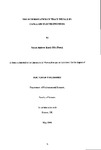THE DETERMINATION OF TRACE METALS BY CAPILLARY ELECTROPHORESIS
| dc.contributor.author | Hardy, Simon Andrew | |
| dc.contributor.other | School of Geography, Earth and Environmental Sciences | en_US |
| dc.date.accessioned | 2013-10-10T09:04:50Z | |
| dc.date.available | 2013-10-10T09:04:50Z | |
| dc.date.issued | 2000 | |
| dc.identifier | NOT AVAILABLE | en_US |
| dc.identifier.uri | http://hdl.handle.net/10026.1/2136 | |
| dc.description.abstract |
The development of a capillary electrophoresis (CE) method for the determination of inorganic and organo mercury species as their dithizone sulphonate (DzS) complexes using coated capillary columns is described. The complexes were pre-formed before injection and detection was by direct measurement of the visible absorbance of the complexes. Dithizone sulphonate was used in place of cysteine to separate methyl mercury in the final stage of a simplified Westoo extraction procedure. The method was than applied to the analysis of methyl mercury in a crab and several fish meat samples. Good quantitative performance is demonstrated by spiking experiments and analysis of DORM-1 certified reference material. The method was found to be very sensitive and a detection limit of 2 µg Kgˉ¹ could be achieved for a l0g sample of fish flesh. A CE method for the determination of uranium (VI) as the arsenazo III complex was developed and the effect of interfering metal ions was studied. The calibration was found to be linear from 10 µg 1ˉ¹ -10 mg 1ˉ¹ using gravity injections and a detection limit of less than 1 µg 1ˉ¹ was achieved with electrokinetic injection. A study was made of injection techniques and their applicability to the enhancement of sensitivity in synthetic standards and environmental samples. The effect of capillary surface chemistry on the peak shape of the migrating uranyl-arsenazo III was also studied using fused silica capillaries with two different internal coatings and three polymeric capillaries. A study was also carried out on the construction and investigation of a post-capillary reactor for the determination of trace metals by UV-Vis absorption after formation of intensely absorbing coloured complexes. The main principle of operation was based on the infusion of the colorimetric reagent into a small 50µm gap between the separation capillary and the reaction capillary. The gap was enclosed by a permeable membrane and the flow of reagent was achieved by the application of a slight pressure to the post-capillary reactor cell. Two reagents were studied, namely, xylenol orange (XO) and 4 (2-pyridylazo) resorcinol (PAR), for the separation and detection of copper (U), cadmium (II), cobalt (II), nickel (II), zinc (II), and manganese (II). Lead (II) was also included in the XO system. | en_US |
| dc.description.sponsorship | Dionex, UK | en_US |
| dc.language.iso | en | en_US |
| dc.publisher | University of Plymouth | en_US |
| dc.title | THE DETERMINATION OF TRACE METALS BY CAPILLARY ELECTROPHORESIS | en_US |
| dc.type | Thesis | |
| plymouth.version | Full version | en_US |
| dc.identifier.doi | http://dx.doi.org/10.24382/4560 | |
| dc.identifier.doi | http://dx.doi.org/10.24382/4560 |
Files in this item
This item appears in the following Collection(s)
-
01 Research Theses Main Collection
Research Theses Main


